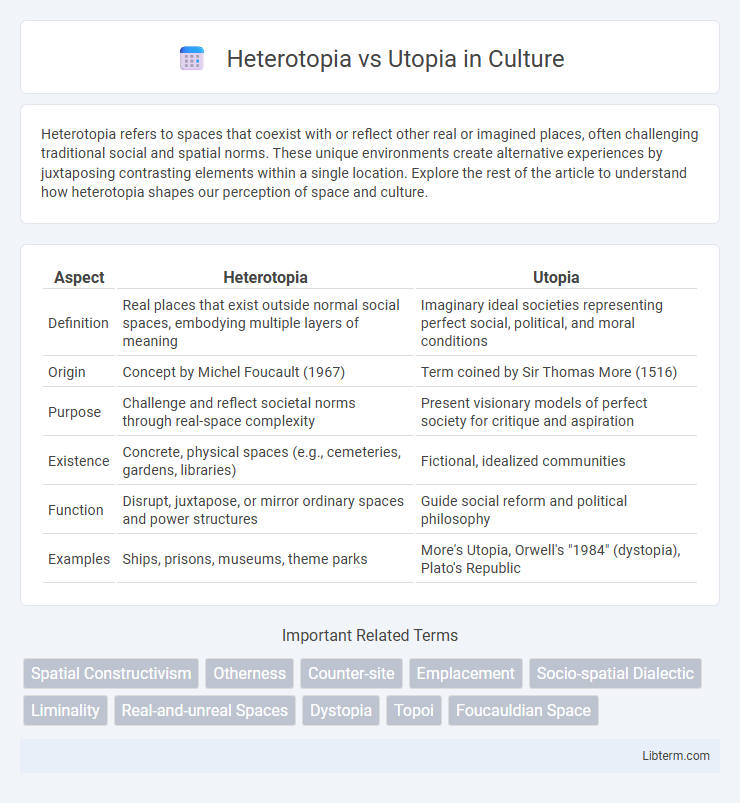Heterotopia refers to spaces that coexist with or reflect other real or imagined places, often challenging traditional social and spatial norms. These unique environments create alternative experiences by juxtaposing contrasting elements within a single location. Explore the rest of the article to understand how heterotopia shapes our perception of space and culture.
Table of Comparison
| Aspect | Heterotopia | Utopia |
|---|---|---|
| Definition | Real places that exist outside normal social spaces, embodying multiple layers of meaning | Imaginary ideal societies representing perfect social, political, and moral conditions |
| Origin | Concept by Michel Foucault (1967) | Term coined by Sir Thomas More (1516) |
| Purpose | Challenge and reflect societal norms through real-space complexity | Present visionary models of perfect society for critique and aspiration |
| Existence | Concrete, physical spaces (e.g., cemeteries, gardens, libraries) | Fictional, idealized communities |
| Function | Disrupt, juxtapose, or mirror ordinary spaces and power structures | Guide social reform and political philosophy |
| Examples | Ships, prisons, museums, theme parks | More's Utopia, Orwell's "1984" (dystopia), Plato's Republic |
Understanding Heterotopia: A Conceptual Overview
Heterotopia refers to real places that exist outside conventional societal norms, embodying a complex layering of relationships and meanings that challenge utopian ideals of perfect or ideal societies. Unlike utopia, which is an imagined perfect world, heterotopias are tangible, functioning spaces such as gardens, cemeteries, or ships that reflect, distort, and contest cultural and social realities. Michel Foucault's concept of heterotopia highlights these spaces as "other" places that organize time and space differently, revealing underlying power structures and offering critical perspectives on human experience.
Utopia Defined: Dreams of a Perfect Society
Utopia, derived from Thomas More's 1516 work, represents an idealized society embodying perfect political, social, and moral systems where equality, justice, and harmony prevail. Dreams of a perfect society emphasize structured communal living, absence of poverty, and universal access to education and healthcare, reflecting humanity's aspiration for flawless governance and ethical standards. Unlike heterotopia, which denotes real spaces of otherness and contradiction, utopia remains a conceptual blueprint for ultimate societal perfection.
Michel Foucault and the Birth of Heterotopia
Michel Foucault introduced the concept of heterotopia in his 1967 lecture "Of Other Spaces," defining it as real places existing outside normative social orders, contrasting sharply with utopias, which are idealized, non-existent spaces. Heterotopias function as sites of otherness, layered with multiple meanings, such as cemeteries, gardens, and museums, reflecting societal heterogeneity rather than perfect harmony. This birth of heterotopia challenges the utopian dream by emphasizing pluralism, spatial complexity, and the coexistence of incompatible spaces within society.
Key Characteristics of Utopia
Utopia is characterized by an idealized, perfect society where social, political, and economic systems function harmoniously to promote equality, justice, and well-being for all inhabitants. It often features meticulously planned environments, absence of conflict, and the implementation of visionary laws that optimize human happiness and prosperity. Unlike heterotopias, which are real places reflecting or contrasting societal norms, utopias exist primarily as conceptual models for ideal living conditions.
Fundamental Differences: Heterotopia vs Utopia
Heterotopia represents real places that exist outside of conventional societal norms, characterized by multiplicity and contradiction, whereas Utopia refers to an idealized, often imaginary society embodying perfect social, political, and moral conditions. Unlike utopias, which present a singular vision of perfection, heterotopias accommodate diverse realities and disrupt normative spaces through their juxtaposition of incompatible sites. The fundamental difference lies in heterotopia's tangible existence and complexity compared to the abstract, aspirational nature of utopia.
Real-World Examples of Heterotopias
Heterotopias represent real-world places that exist in parallel or contrast to ordinary spaces, such as cemeteries, gardens, or museums, where societal norms are suspended or inverted. One prominent example is the airport, a liminal space facilitating movement and cultural convergence, reflecting temporal and spatial heterogeneity. Unlike utopias, which envision idealized, perfect societies, heterotopias embody tangible, complex environments revealing multiple layers of meaning and social function.
Utopian Ideals in Literature and History
Utopian ideals in literature and history represent visionary concepts of perfect societies characterized by harmony, equality, and justice, as seen in Thomas More's "Utopia" and Plato's "Republic." These ideals often emphasize structured social order, communal ownership, and progressive governance as solutions to contemporary societal flaws. Despite their aspirational nature, utopian narratives critically reveal the complexities and potential flaws in pursuing absolute perfection in human communities.
The Influence of Space and Place in Heterotopia
Heterotopia, unlike utopia, represents real places layered with complex meanings reflecting societal contradictions, highlighting the influence of space and place in shaping human experience. These spaces act as mirrors to society, revealing marginalized or hidden aspects through their unique spatial organization and temporal disruptions. The concept emphasizes spatial heterogeneity, where physical environment intersects with social norms, challenging the idealized perfection found in utopian visions.
Social Implications: Heterotopic vs Utopian Spaces
Heterotopic spaces embody social diversity by juxtaposing multiple realities and challenging dominant norms, fostering inclusivity and critical reflection in society. In contrast, utopian spaces propose idealized, often homogeneous environments aiming at social perfection, which can exclude difference and suppress dissent. These contrasting spatial paradigms influence social organization by either embracing complex, fragmented identities or promoting uniformity and consensus in community life.
Rethinking Ideal Spaces: Contemporary Relevance
Heterotopia challenges the fixed notion of utopia by embracing multiplicity and real-world complexities, offering a framework to rethink ideal spaces beyond perfection. Contemporary relevance lies in heterotopia's capacity to accommodate diversity and contradiction within social, cultural, and urban contexts, unlike utopia's often rigid, singular vision. This contrast prompts new approaches to designing inclusive, adaptable environments that reflect lived experiences rather than unattainable ideals.
Heterotopia Infographic

 libterm.com
libterm.com